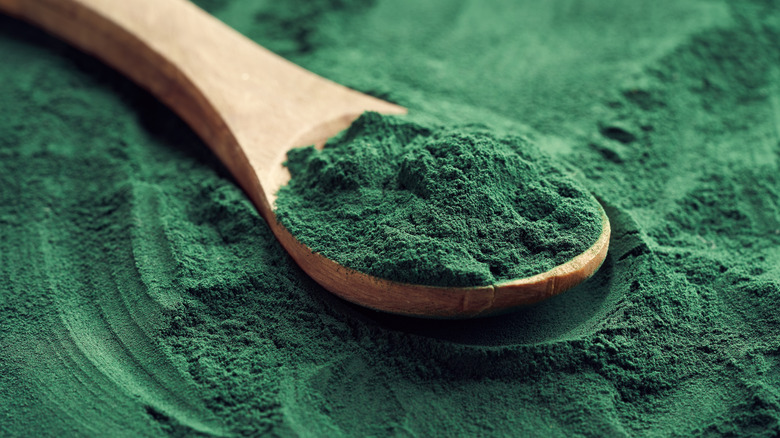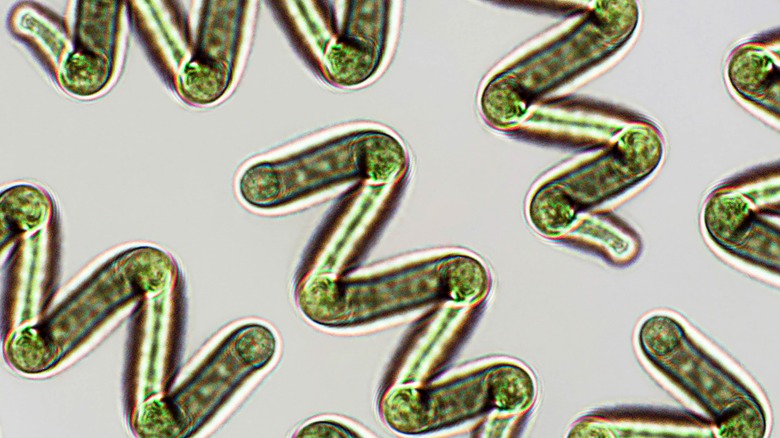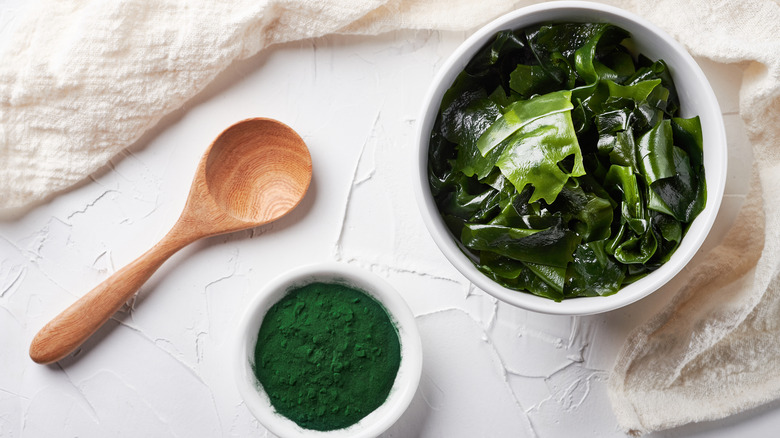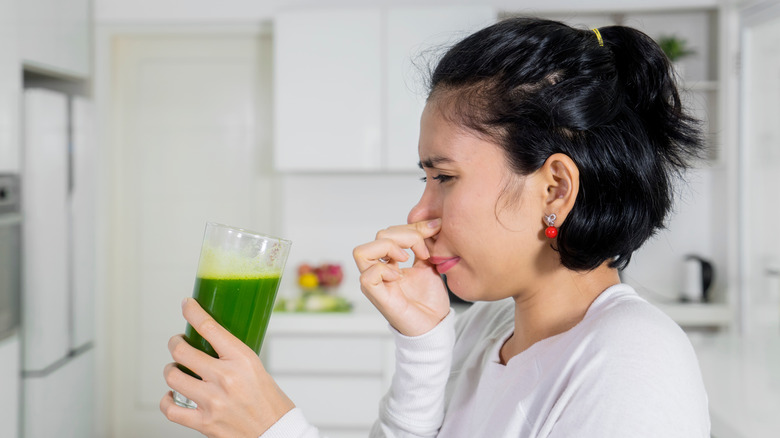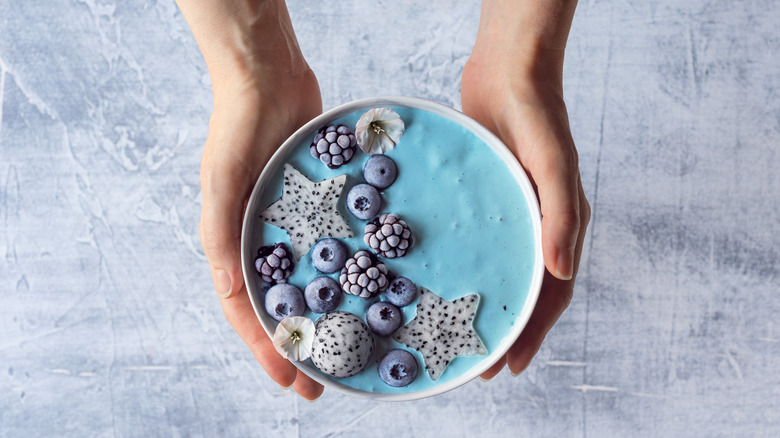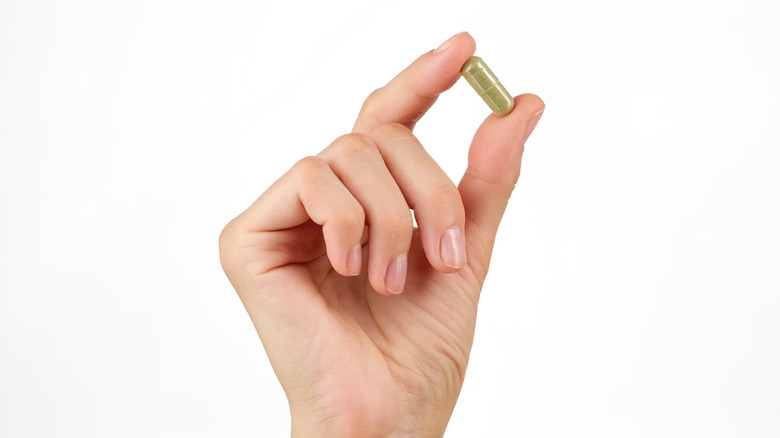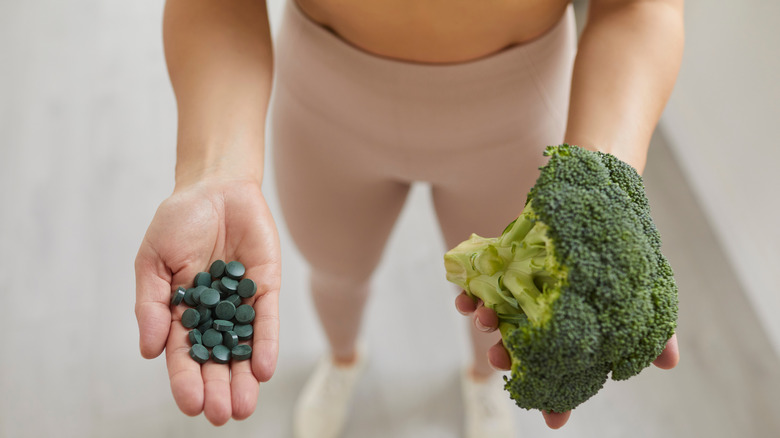What Is Spirulina And How Do You Use It?
From the depths of lakes to the vastness of space, spirulina is an other-worldly micro-algae with infinite potential, per the NASA Technical Reports Server. Widely considered a prokaryotic lifeform, spirulina is one of the oldest microorganisms in the world and has been linked to the formation of the Earth, cited as the planet's first source of oxygen, via the MIT Department of EAPS. Spirulina and its fellow algae friends have the potential to be used as sources of carbon-neutral fuel, agriculture and aquaculture feed, and plant-based protein for humans. But what about the here and now?
Modern-day spirulina continues to live up to its ancient history. It was first sourced in Aztec and Kanem civilizations as early as the ninth century AD, per the Gaia Herbs Farm. Its original uses in aiding diseases and sustaining energy have been backed by science today. While it is no longer consumed as dry flakes, spirulina is commonly infused into everyday foods to give them a healthy edge. From ice cream to kombucha, chocolates to protein bars, and smoothies to pasta sauce, these tiny blue-green algae continue to reign as one of the most nutrient-dense foods on Earth, according to Healthline.
What is spirulina?
Scientifically known as Arthrospira platensis, spirulina is not considered a plant but a type of algae. There are more than 30,000 algae forms on the planet, and they're all categorized by color. But spirulina is considered blue-green algae, which also classifies it as a micro-organism known as cyanobacteria, per FoodUnfolded. As cyanobacteria, spirulina exhibits plant-like characteristics such as its power to create its own food through photosynthesis; however, it also has surprising abilities that set it apart.
Unlike plants, spirulina has no membrane-bound nuclei, making them prokaryotic rather than eukaryotic. In fact, spirulina is a unicellular organism that lacks any DNA structure whatsoever. Their pasta-like name is also in their shape, which surprisingly resembles a spiral fusilli, according to The Fox Magazine. Spirulina can also freely roam about its natural environment and typically grows in colonies within mineral-rich bodies of water, usually located near volcanoes, per Auroville.
How is spirulina made?
The days of foraging for spirulina are long gone. While some of the largest concentrations of spirulina are still found in Mexico and Africa, according to Auroville, modern agricultural practices have made it available anywhere a body of fresh water is present. From lakes to ponds, to rivers, and even pools, the sustainability of spirulina farming is why the algae are considered essential to achieving carbon neutrality.
Because spirulina grows naturally in water, it requires low amounts of land and water to grow. Even when cultivated indoors, the water can be recirculated indefinitely — using more than 14 times less water than modern-day beef production. Additionally, a 2019 report found that spirulina can fixate with carbon in the atmosphere, which offsets emissions to require nearly 20 times less carbon dioxide than the equivalent protein content of beef (via We Are The New Farmers).
After the algae have been grown and harvested, the next steps in how spirulina is made depend mainly on its form: powdered, pilled, or fresh. If the spirulina is sold as powdered or pilled, it must be dried to prevent oxidation and maintain the algae's valuable carotenes and fatty acids. The best way to do this is through a dry freezing process, where the algae are immersed in a liquid form of nitrogen and carbon dioxide, per Nutrex Hawaii. After it's been dehydrated, the spirulina is crushed, pilled, and packaged for consumption.
However, spirulina can also be bought fresh. In this case, after the algae are grown and harvested from the water, they are gently pressed — similar to how you'd press tofu — to drain the extra water absorbed slowly. In the process, the spirulina transforms into a soft paste that is then refrigerated or frozen to maintain peak freshness and sold in convenient containers for you to enjoy, according to We Are The New Farmers.
Fresh spirulina vs dried
Fresh spirulina may not be as easy to find at your regular grocery store. But because of its water content, more of its essential enzymes and antioxidant compounds are maintained when in other forms. Spirulina's natural bioactive compounds, or enzymes, are what allow our bodies to break down and absorb all of the algae's nutrients. One 2015 study showed that, compared to its dried counterpart, fresh spirulina contained more bioactive compounds like carotenoids, chlorophyll, phenols, and flavonoids, per ScienceDirect. These essential elements are removed during the drying processes used to create powdered and pilled spirulina products. In addition to its delivery of nutrients, the taste and paste-like texture of fresh spirulina make it more suited for use in smoothies and food.
While dried spirulina is more readily available at stores, its uses are slightly limited. It can be taken as a pill, diluted in water or juice, or mixed into a smoothie. Still, unless the spirulina has been dried and processed to maintain its nutrition content, it won't have as many benefits as fresh spirulina. Despite their convenience, the tablets are infused with as much as 20% fillers and binders that dilute nutrient absorption, according to the Australian Spirulina. The same goes for powdered spirulina, which is often mixed with additives that prevent clumping, via We Are The New Farmers. So, to get the same amount of nutrients from pure spirulina, you'd have to consume more of it.
What does spirulina taste like?
Because spirulina grows underwater, it tends to taste like it sometimes. At its best, spirulina has a subdued earthy tone similar to the taste of seaweed. Its flavor pairs well with other green vegetables or is balanced within a sweeter profile, which is why it's commonly used in green smoothies and fruit juices. However, this taste can quickly go from mild and earthy to smelly and fishy if it's not treated correctly.
The tell-tale sign that your spirulina is poor quality is its smell. Good spirulina may have a slightly salty ocean scent, but it should never be overwhelmingly so. As cyanobacteria, spirulina is a natural prebiotic that can do wonders for your digestive system. While its fermented nutrients aid gut health, if not correctly handled, they can create high bacteria counts that produce the strong, fishy smell you may have previously experienced, per Earthrise.
Spirulina in smoothies and beyond
Beyond taking spirulina as a pill or mixing its powder into a glass of water, there are plenty of creative and digestible ways to take in all of its nutrients. Have you ever seen a bright, blue smoothie bowl on your Instagram feed? That gorgeous color is all thanks to spirulina! The blue-green algae act as a natural colorant that brings beautiful deep shades of green and blue to fruit smoothies, yogurts, and chia puddings while boosting nutrients and protein.
But spirulina has more purposes besides green juices and smoothie bowls, and just because it's a superfood doesn't mean it can't be mixed into other things. From desserts like pie, chocolate, and ice cream, to savory dishes like scrambled eggs, pesto, and omelets, spirulina has a surprising ability to take on new roles in unexpected cuisines, per The Ful Scoop. Just be sure to do your research and read the reviews first because nothing is enticing about fish ice cream — unless taiyaki is on the menu.
Where to buy spirulina
Dried spirulina is relatively common to find these days, but just because something is convenient doesn't mean you're getting the best quality. A 2013 study published in the Saudi Journal of Biological Sciences sampled 25 spirulina products and found low levels of heavy metals, including lead, mercury, cadmium, and arsenic. These metals were traced as contaminants from pesticides and fertilizers commonly used in agricultural areas, and the spirulina attracts and absorbs them even if not used directly as accumulators.
So sure, you could pick up any old spirulina supplement in the vitamin section or powder from the organic health food aisle at your local supermarket. Or better yet, order some on Amazon, but when it comes to these algae, it's vital to invest in high-quality. For this reason, it's best to purchase spirulina from brands like We Are The New Farmers or Nutrex that use a controlled environment. Not only will you avoid the off-putting pungent ocean aroma that's so common in the less-expensive options, but you'll feel confident knowing exactly where it came from.
Spirulina benefits and side effects
As one of the most nutritious foods on the planet, spirulina packs a potent punch of health benefits into microscopic algae that are not only sustainable but also accessible. In fact, at the 1974 United Nations World Food Conference, spirulina was declared "the food of the future" and the key to eradicating malnutrition through its delivery of protein, iron, and essential nutrients, according to the IIMSAM-IGO. Through their efforts, people in more than 70 countries are consuming spirulina and reaping its benefits.
Spirulina is a plant-based powerhouse of protein often compared to eggs for its delivery of all nine essential amino acids, via Healthline. Only the protein in spirulina can reduce cholesterol absorption and triglyceride levels while increasing nitric oxide that relaxes blood vessels, making it a major defender against heart disease, diabetes, pancreatitis, and blood cots, per WebMD. This tiny alga is also rich in vitamins like vitamin A as beta carotene and vitamins C, D, and E, which are all great for the immune system, eye and bone health, and energy production, according to Mount Sinai. Finally, spirulina is a powerful source of antioxidants, the most potent being phycocyanin, which gives it its rich blue-green color. It has also been shown to eliminate cancer cells and prevent the growth of tumors.
The list of spirulina's benefits goes on and on; however, due to its high count of active nutrients, risks are involved. A 2017 study published in the Journal of Applied Phycology discovered spirulina had side effects, particularly in those with pre-existing conditions. As always, you should consult your doctor before starting spirulina supplements to rule out potential health problems. It's also important to note that, due to the likely heavy metals, spirulina is not recommended for use by pregnant women or those with liver problems, states WebMD.
Varieties of spirulina
As discussed, spirulina typically comes in a few different varieties, including pilled, powdered, fresh, and frozen. While the pilled and powdered forms are the easiest to get, they aren't particularly great if you incorporate your spirulina in food or smoothies. Not only do these products typically contain fillers, but they're more prone to tasting and smelling like fish due to the drying process, according to the Australian Spirulina. On the other hand, these are great options if you want the convenience of getting spirulina's benefits on the go while traveling or simply can't be bothered to make a smoothie or juice every morning.
But if you're a green smoothie fiend, frozen or fresh spirulina will be your best friend. Forget blanching and freezing your kale every week or chopping up endless amounts of veggies in the morning because spirulina gives you just as many benefits, if not more, without the hassle. Besides the convenience, the paste-like texture of fresh and frozen spirulina will only add to the creamy texture you want for your smoothies. It also won't leave you with clumps or shreds of greens like kale, and spinach, or other green veggies would. With frozen and fresh spirulina, you have the power to instantly transform any juice or smoothie recipe into a green one — without sacrificing flavor.
